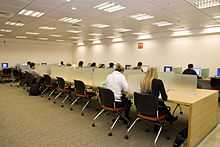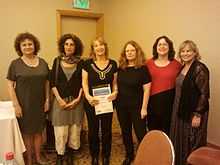Library assessment
Library assessment is a process undertaken by libraries to learn about the needs of users (and non-users) and to evaluate how well they support these needs, in order to improve library facilities, services and resources. In many libraries successful library assessment is dependent on the existence of a 'culture of assessment' in the library [1] whose goal is to involve the entire library staff in the assessment process and to improve customer service.
Although most academic libraries have collected data on the size and use of their collections for decades, it is only since the late 1990s that many have embarked on a systematic process of assessment (see sample workplans)[2][3] by surveying their users as well as their collections.[4] Today, many academic libraries have created the position of Library Assessment Manager[5] in order to coordinate and oversee their assessment activities. In addition, many libraries publish on their web sites the improvements that were implemented following their surveys [6][7][8][9] as a way of demonstrating accountability to survey participants.
Several libraries have undertaken renovation or expansion projects as a result of their assessment activities[10] as well as enhance resource discovery tools, improve web site usability and stop redundant services.[11]

Tools
In order to determine what is important to library users and how satisfied they are with services, resources and physical space, library assessment utilizes a variety of research methods such as:[12][13] website usability testing, observation, 'In-Library Use' surveys,[14] focus groups, interviews, wayfinding, balanced scorecard, furniture usability, photo and mapping surveys, organizational climate, statistics and satisfaction surveys. The most widely used library satisfaction survey is LibQUAL+,[15] a service quality evaluation survey developed by the Association of Research Libraries (ARL) based on ServQUAL. Other satisfaction surveys are: the SCONUL Satisfaction Survey,[16] Insync Surveys (formerly Rodski),[17] and Counting Opinions LibSat survey.[18]
USA, UK, Australia and Israel

One notable exception is Israel whose University of Haifa Younes and Soraya Nazarian Library began a systematic process of library assessment in 2007, and has been conducting a Hebrew version of the University of Washington's 'In-Library Use' survey [25] since 2008, and LibQUAL+ Lite (also in Hebrew)[26][27] since 2009 in three-yearly cycles.

Conferences
The library assessment community holds two biennial conferences: the Library Assessment Conference (LAC)[28] in USA and the Northumbria Performance Measurement Conference [29] which is generally held in Europe. Also relevant are the annual Qualitative and Quantitative Methods in Libraries Conference (QQML)[30] and the annual Evidence Based Library and Information Practice Conference (EBLIP).[31]
Courses
Although courses on library assessment are not commonplace on the curricula of library schools, in the past few years several schools have opened courses, such as: the University of North Carolina at Chapel Hill School of Information and Library Science[32] and the joint Digital Library Program of Oslo and Akershus University College of Applied Sciences, Norway, Tallinn University, Estonia, and the University of Parma, Italy.[33]
References
- ↑ Lakos, A. (2002). Culture of assessment as a catalyst for organizational culture change in libraries. In J. Stein, M. Kyrillidou, & D. Davis (Eds.), Proceedings of the Fourth Northumbria International Conference on Performance Measurement in Libraries and Information Services: Meaningful Measures for Emerging Realities, (pp. 311-319). Washington, DC: Association of Research Libraries.
- ↑ University of Haifa, Library Assessment Team workplan
- ↑ Writing a library assessment workplan
- ↑ Hiller, S. & Self, J. (2004). From measurement to management: using data wisely for planning and decision-making. Library Trends, 52(1) 129-155.
- ↑ Wright, S. P. & Association of Research Libraries (2007). Library Assessment: SPEC Kit 303, Washington, D.C., Association of Research Libraries.
- ↑ University of Haifa, You Said...We Did
- ↑ University of Manchester, You Said... We Did
- ↑ University of East London, You Said...We Did
- ↑ University of Northampton, You Said...We Did
- ↑ Gerke, J. & Maness, J. M. (2010). The physical and the virtual: The relationship between library as place and electronic collections. College & Research Libraries, 71(1), 20-31.
- ↑ Storey, T. (2006). Are you asking the ultimate question? Next Space: The OCLC Newsletter, 5, 10-11.
- ↑ Hernon, P. & Calvert, P. J. (1996). Methods for measuring service quality in university libraries in New Zealand. The Journal of Academic Librarianship, 22(5), 387-391.
- ↑ Nitecki, D. A. (2001). Quality assessment measures in libraries, Advances in Librarianship, 25, 133-162.
- ↑ University of Washington, 'In-Library Use' surveys
- ↑ Heath, F. (2011). Library assessment: The way we have grown. Library Quarterly, 81(1), 7-25.
- ↑ SCONUL Satisfaction Survey (UK)
- ↑ Insync Satisfaction Survey (Australia)
- ↑ Counting Opinions LibSat survey (USA)
- ↑ Martensen, A. & Gronholdt, L.. (2003). Improving library users perceived quality, satisfaction and loyalty: an integrated measurement and management system. The Journal of Academic Librarianship. 29(3), 140-147.
- ↑ Wright, S. P. & Association of Research Libraries. (2007) Library Assessment: SPEC Kit 303, Washington, D.C., Association of Research Libraries.
- ↑ University of Washington, Library Assessment site
- ↑ University of Virginia, Library Assessment site
- ↑ University of York, Library Assessment site
- ↑ Council of Australian University Libraries (CAUL), Library Assessment site
- ↑ University of Haifa, 'In-Library Use' survey
- ↑ Falk, E. & Gorenstein, L. (2010). The academic library as seen by researchers: An evaluation of the satisfaction of faculty members and PhD students with the Hebrew University of Jerusalem's library services Meidat, 6, 31-45. (in Hebrew)
- ↑ Porat, L. (2009). LibQUAL+ Lite in Hebrew 8th Northumbria International Conference on Performance Measurement in Libraries and Information Services, Florence, Italy.
- ↑ Library Assessment Conference (LAC)
- ↑ Northumbria Performance Measurement Conference
- ↑ Qualitative and Quantitative Methods in Libraries (QQML)
- ↑ Evidence Based Library and Information Practice Conference (EBLIP)
- ↑ University of North Carolina, Library Assessment course
- ↑ University of Parma, Library Assessment course
Further reading
- Hernon, P. & Altman, E. (2010). Assessing Service Quality: Satisfying the Expectations of Library Customers. Chicago, American Library Association.
- Hiller, S. & Porat, L. (2009). Academic library as place: Users and uses. 8th Northumbria International Conference on Performance Measurement in Libraries and Information Services, Florence, Italy.
- Kyrillidou, M. (2009). Item Sampling in Service Quality Assessment Surveys to Improve Response Rates and Reduce Respondent Burden: The 'LibQUAL+ Lite' Randomized Control Trial (RCT). Doctoral dissertation, University of Illinois at Urbana-Champaign, Illinois, USA.
- Matthews, J. (2007). The Evaluation and Measurement of Library Services. Westport, CN., Libraries Unlimited.
- Poll, R. & Boekhorst, P. T. (Eds.). (2007) Measuring Quality: Performance Measurement in Libraries. 2nd rev. ed. Munich: K.G. Saur.
- Porat, L. (2010). Marketing and assessment in academic libraries: A marriage of convenience or true love? 3rd Library Assessment Conference, Baltimore, USA.